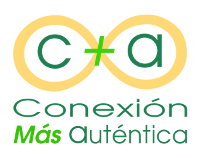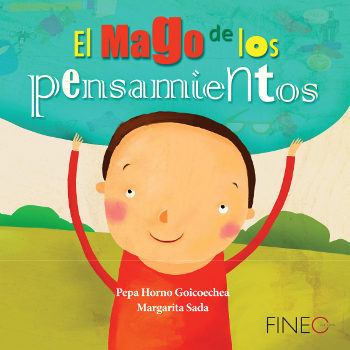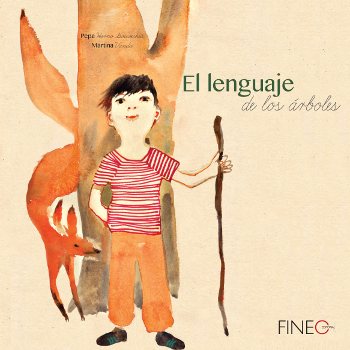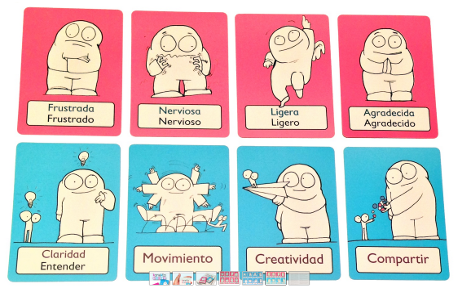Label: For boys and girls
Video series for children, girls and adolescents made for UNICEF Spain
22 July 2020.
Tags: CI Spirals, Focusing, My Classifieds, My videos, For Teens, For boys and girls, For parents, Videos, Experiences
Since the beginning of the pandemic, many children's organizations have struggled to create resources. From Spirales Consultoría de Infancia we have prepared several different materials.
In this blog post I want to share some videos that are also relevant to what I am sharing here, for many reasons.
- They put forward messages that are clear and broad enough to discuss with children, girls and adolescents on the COVID-19 pandemic, so that they have clues about what is happening to them.
- They propose a work on body awareness: from the model of the three intelligences to coming into contact with the breath, with the tension or with the different sensations. It is not Focusing, but aim for that sensitivity.
- They are in Spanish, but also in French and Moroccan Arabic. I was excited to use in these videos these two languages that have served me so much to communicate when I lived in Morocco and with migrant adolescents in Spain.
I leave you the videos below:
I hope you find them interesting.
Story “The Wizard of thoughts” Pepa Horno on listening to the body by caressing
11 July 2016.
Tags: Education, CI Spirals, Focusing, For boys and girls, For parents, Textos Focusing, Other Texts
In line continue to celebrate the publication a year ago tales of Pepa Horno, my good friend and partner in Spiral Consulting Children (where we work on issues of affective education in childhood), This complements entry the previous one, referring to his book The language of trees. this story, The Wizard of thoughts, It has been published by the Editorial Phineus with illustrations Margarita now.
Pepa same account his intention for this book with the following words:
The Wizard of thoughts He speaks of fondling, and how caresses and massages serve to emotional self-regulation, for these children than adults say they still do not stop, who fail to sort their thoughts, or silence them or concentrate ... For these children have a "magic" trick to put some order within himself. In those thoughts that basically are but the fruit of his extraordinary sensitivity.
To this I add that it is a story that can be adapted perfectly to teach Focusing boys and girls for the following reasons:
- Presents a positive and welcome sight of thoughts, sensations, feelings, emotions and experiences in general with children (and we also have adults): what is within us it makes sense if you provide adequate listening.
- Children can do concrete things to pay attention to their internal experiences, so these calm down (and, although not explained in the story, Also to be deployed), and those who are around him can accompany.
- Internal experiences are accompanied by more effectively with any physical action. Pepa proposed in the story caresses the areas involved (head of the protagonist, in this case), but explained on the last page, “Words for the soul of adults”, there may be many other ways, whenever it involves the body.
So I heartily recommend this book as a way to present the Focusing in a manner adapted to children.
I hope you will like it as much as me,
Xavier
Story “The language of trees” Pepa Horno to accompany the child duel (and for all ages)
13 June 2016.
Tags: Mourning, CI Spirals, For boys and girls, For parents, Other Texts
It has recently completed the first anniversary of the publication of the story The language of trees of Pepa Horno, my dear friend and partner in Spiral Consulting Children (where we work on child protection issues). this story, published by the Editorial Phineus and illustrated by Martina Vanda, had several presentations, and the first was in the Book Fair of Madrid 2015 at this time, so I thought proper to remember with this blog.
Pepa presents the book as follows:
The language of trees about death. Or rather on the thread of love that binds either side of life. He speaks of people who have the heart divided, "Half on land and half in heaven", and it is written for many children (those who are children now and those other children hidden under the skin of adults) with his heart so.
I want to highlight three aspects that recommend this story (and that is why I have already given more than one occasion):
- The importance of discovering a symbolic link to the deceased, can be grown in life or after death has occurred. Never too late to create a ritual that produces us feeling connected to those we still alive.
- Body dimension bereavement, masterfully displayed targeted. Take a walk, move around the field, gestures with the body… It helps us to better process losses, regardless of age.
- Tenderness that permeates the work invites us to take care of the relationship in every situation of mourning with all children: with those who are age, and who took our children and girls indoor inside (and also they need your attention).
For all this and much more is a book I consider recommended reading, and especially to have on hand when losses occur in the environment.
Hope you enjoy it as much as the IM.
Xavier
My article on “Children and death”
31 October 2015.
Tags: Interpersonal communication, Mourning, Education, My Classifieds, For boys and girls, For parents, Psychotherapy, Therapy, Other Texts
In these final days of October the theme of death more frequently in the lives of children arises. Since the celebration of the Day of the Dead in certain families to all events of a different color of the Halloween, the reality is that it is a time when children can ask questions about death, and it is convenient to have prepared certain attitudes and listening spaces and answers.
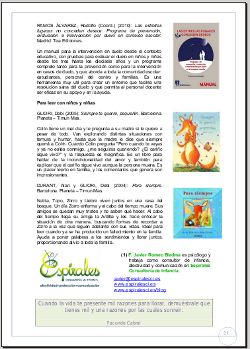 I wrote in 2011 an article that recovery here, “Children and death”, to remember some useful clues. In the article, published in the journal Our corner of 0-6 - ACCENT directed Childhood Education, They explore three key areas:
I wrote in 2011 an article that recovery here, “Children and death”, to remember some useful clues. In the article, published in the journal Our corner of 0-6 - ACCENT directed Childhood Education, They explore three key areas:
- The perception of death at different ages (between zero and six years, which it is the subject of the magazine).
- Some basic guidelines to accompany children to death.
- recommended reading, separate readings for families and professionals and stories to read with children.
Article framing and start with this paragraph:
For a long time it was thought that children did not suffer grieving process until older ages. However, research in the field of addiction have shown that pass through grieving process from the earliest ages, although it does not manifest like adults until later. Therefore it is necessary to speak of death (and not hide it for fear of damaging them) when it happens (or when it will happen, in the case of terminally ill), to understand 1) that the person is definitely going and 2) that the person does not leave voluntarily, and also so they can say goodbye, because if these concepts are not clear and not a farewell occurs, a pathological mourning may appear. And so it is important that we listen and pay attention to what happens inside when the death occurs in their lives.
[cite as: ROMEO BIEDMA, Francisco Javier (2011): "Children and death" Our corner of 0-6 - ACCENT, 60, 17-21.]
I hope that these reflections will serve to accompany this topic to children in your environment. Death is an inevitable part of life, and how better integrate, They will live more fully, our children and us.
I wish you a commemoration consciousness,
I understand how psychotherapy: Key ideas and a video to illustrate
3 March 2015.
Tags: Interpersonal communication, For Teens, For boys and girls, For parents, Psychotherapy, Therapy, Videos
Explain to anyone what the psychotherapy, and especially what I understand as psychotherapy, It is always a challenge. And when this is added we want to explain it to children, or adolescents, It finds it harder. And yet, psychotherapy is perfectly natural: to recover the lost balance (and thus regain control of their lives).
As human beings we are basically ready to grow healthily. It would be natural that all people might be moving through the various stages of childhood, adolescence and adulthood step. It would be natural, well, on the one hand to incorporate the nutrient elements psychologically (body, emotional, cognitive, procedural, attitudinal…) and on the other hand trying to overcome the painful and even harmful elements with new learning (of the kind “This attitude of mine and does not serve me” The “I do not ever want to deal with a person who does not respect me”). However, Sometimes things go wrong (a little or a lot), and you need to do something to move forward with health. Psychotherapy is a good way to integrate and heal the experiences, regaining enthusiasm for our life.
The video “Garra rufa (Doctor Fish)”, It was developed by a group of students of animation Sheridan College under the name of Frozen Mammoth Productions, among others Timothy Chan and Eunice Hwang, and we can serve as the starting point to begin reflection.
This video seems a good example to explain several key points that I like to make clear to children and adolescents, and also adults who pose make a psychotherapy:
1) The work of those who act as therapists is recover the healthy and alive who's inside we see. We all have something valuable by the mere fact of its existence, although sometimes very harmful situations have occurred, the external internal.
2) To recover what we have healthy and alive variety of means, Suitable whom we have before (and at his age, their likes, his style, what has lived…). always we hear, often we ask, and sometimes we propose activities (how to draw, or perform specific activities, or trying different techniques). Our goal is to give back to the person that he is healthy and alive, but cleaner and stronger so you can move your life.
3) We know that the process takes time. If we take weeks, months, years, living with painful, we will also need time to heal dedication. It is true that there may be discoveries that we radically change our experience at a time, as it appears in the video, but that only happens when we have been investigating our inner enough. And it takes time for that experience is put in place globally in our lives.
4) And we know that The process involves an effort. It's like cleaning a wound that has become infected, It may involve momentary pain, but the improvement is evident in the long run. The effort affects people who are around who comes for consultation. For children, and adolescents, the effort affects the family, and from my vision of psychotherapy I intervene only if there is a clear and strong commitment from family (especially primary caregivers).
5) As in the video, as therapists know well the experience because We have lived our own psychotherapy with our own challenges. Of course we have specific training, broad and deep, but we do not consider exceptional people. We are simply people who have watched our pain and we have learned to look at the pain of others constructively and from new perspectives.
I hope the video will serve you to have some clearer ideas about psychotherapy, especially when you please explain the your children, and adolescents.
Xavier
Letters feelings and needs “EASY Konekta” de Simple Cat
6 February 2015.
Tags: CNV, Interpersonal communication, Education, For boys and girls, For parents
Nonviolent Communication It is a very profound tool, which should be developed by all means and through all possible channels. Those who have done workshops with me have seen the profusion of resources use (visual, space…), among other letters I-crafted, and I use over several years.
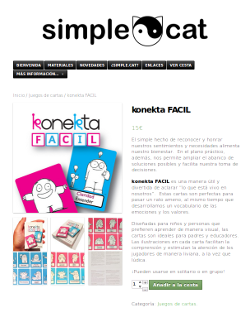 I was pleased a lot with the recent appearance of the letters “EASY Konekta”, a resource useful to accompany the processes of people who rely on the visual, especially children. In Simple Cat, a small company that is striving to bring and create teaching materials for training in Nonviolent Communication in Spain, They have chosen to launch these cards own design.
I was pleased a lot with the recent appearance of the letters “EASY Konekta”, a resource useful to accompany the processes of people who rely on the visual, especially children. In Simple Cat, a small company that is striving to bring and create teaching materials for training in Nonviolent Communication in Spain, They have chosen to launch these cards own design.
I just received letters “EASY Konekta” and I liked many aspects. On the one hand, the design, with simple drawings that make the cards very affordable, with pink background for the feelings and needs blue background (a code and universalized in the community of Nonviolent Communication by NVC Dance Floors).
On the other hand, the way they caring words: feelings are masculine and feminine, so that everyone can feel included us easily; and needs are often expressed in two complementary ways, so that the person can explore what is the word that fits you best.
Further, add a number of proposed use (Game suggestions), adapted from other sources with your permission, including the famous “Póker CNV”, that I use in deepening workshops.
From here my congratulations to the team Simple Cat this new resource. I'm looking forward to my next workshop try and see what they think those involved. Meanwhile you can explore more on the cards in the página web and you can buy them online if you're interested.
I trust that you are practical and easy to deepen Nonviolent Communication.
Xavier
NVC Dance Floors: practice Nonviolent Communication in a holistic manner
25 September 2014.
Tags: CNV, Interpersonal communication, Education, In English, My Classifieds, For Teens, For boys and girls, For parents, Psychotherapy, Therapy, Texts CNV, Videos
The NVC Dance Floors have already appeared in the version in Castilian, in which I have worked, and are also available videos subtitled in Spanish.
Bridget Belgrave and Gina Lawrie, Certified trainers for the Center for Nonviolent Communication (Center for NonViolent Communication, CNVC), years they created a great tool to teach and practice Nonviolent Communication (CNV). As they themselves have in submission, the NVC Dance Floors (NVC Dance Floors) They emerged through a series of steps to facilitate the practice of Nonviolent Communication with a spatial maps that allow use body size to work the emotional dimension, the way you see in this video:
In summer 2009 formarme had the pleasure to meet with Gina and Bridget, From there already work resumed translation and adaptation to the Castilian, an effort in which we have helped many people and I have coordinated for a while. So it is a pleasure to spread a simple tool and yet so deep, finally in Spanish, in which we care to include the largest possible number of Spanish version.
My experience is that the NVC Dance Floors the people can practice with just a few initial knowledge of Nonviolent Communication (In fact I sometimes use in introductory workshops). Even people who do not know the process of Nonviolent Communication itself (children, and adolescents, therapy clients) They can easily cross it with help from someone more experienced.
The NVC Dance Floors combine the visual, corporal and language, so that experience occurs through more channels and experience is deeper. And there are nine “dances” different, with names such as “The Dance of the 13 Steps”, “Integration and Dance Connection”, “The Dance of Anger / Rage, Shame and Depression”, “Dance of Yes and No”, The “Transform the pain of unmet needs in the Beauty Needs”.
Further, in 2013 they released some videos that explain three of these dances, in a neat edition that includes Spanish subtitles.
If you want to buy the dance floor CNV in different formats (as a download in PDF, on paper, plasticized version…) and DVDs to learn them at home or in group practice, you can visit its online store, Life Resources.
And if you want to count on me to try the dance floor in one session or in specific workshops, I will be happy to accompany.
I hope you like.
Xavier
Change the world gesture gesture
6 January 2014.
Tags: For Teens, For boys and girls, For parents, Videos, Experiences
The beginning of the year is a time of good intentions, new projects and renewed hopes. All these early steps will need, perhaps very small steps at first. This video captures the idea of changing the world gesture gesture.
There are times for big moves, for radical changes, Greatest Hits for rudder.
And there are also times for small changes, for modification of detail, for “do the same but in a different way”.
The story of this video is that the Czech organization The intersection of Olomouc reorganizes a series of advertisements Liberty Mutual, an insurance company has made over the years a number of advertising campaigns to enhance public accountability. In this adaptation the little things we can do every day to make the world a little better collect, regardless of ideological positions or any. And we knew that they might not get from the people we help (although reciprocity is critical to the fundamental relations), as in the video, but our actions can inspire others, and will probably never know the fruit.
I wish you happy 2014, with awareness and significant contributions to the world.
Xavier
Book “Cuentos para descubrir inteligencias” de Begoña Ibarrola
4 September 2013.
Tags: Education, Narrative, For boys and girls, Other Texts
For its relevance to the development of an empathic attitude toward the capabilities we have everyone, regardless of our age and skills we have developed, copy content here entry I posted on Espirales Consulting Children, because it reflects a very hopeful vision of the human being.
Ever since I read about the theory of multiple intelligences, proposed and developed by psychologist Howard Gardner, He attracted me deeply. This American psychologist proposed in 1983 that intelligence was not unique (measuring the traditional tests are the logical-mathematical language and intelligences), it was multiple (the number has been increasing over the years and research), and also that each of the intelligences may develop. Since then he has combined research with the development of specific teaching materials for a more comprehensive education, and his work has been recognized by many institutions, including the Prince of Asturias Award for Social Sciences in 2011.
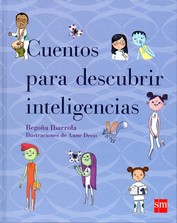 Begoña Ibarrola, a psychologist specializing in emotional development during childhood, us about a fun way to different intelligences in his book Cuentos para descubrir inteligencias, published by the grupo SM with endearing illustrations by Anne Decis. The story of a journey of a group of children terrestrial Pegasus, where they meet other children aliens, an excuse to explore the linguistic intelligences (ability with words and language), Mathematical logician (on numbers and logical operations), visuospatial (the ability to manage spatial and visual data, as in the graphic arts and engineering), musical (it has to do with music), bodily-kinesthetic (everything related to the body and movement), intrapersonal (on internal self-awareness capabilities), interpersonal (it has to do with social and group relations), naturalist (sensitivity to nature) and existential (the ability to reflect on the existence and other philosophical topics). Each component of the terrestrial group is paired with another Pegasus and together explore the intelligence that represent different stories of the book.
Begoña Ibarrola, a psychologist specializing in emotional development during childhood, us about a fun way to different intelligences in his book Cuentos para descubrir inteligencias, published by the grupo SM with endearing illustrations by Anne Decis. The story of a journey of a group of children terrestrial Pegasus, where they meet other children aliens, an excuse to explore the linguistic intelligences (ability with words and language), Mathematical logician (on numbers and logical operations), visuospatial (the ability to manage spatial and visual data, as in the graphic arts and engineering), musical (it has to do with music), bodily-kinesthetic (everything related to the body and movement), intrapersonal (on internal self-awareness capabilities), interpersonal (it has to do with social and group relations), naturalist (sensitivity to nature) and existential (the ability to reflect on the existence and other philosophical topics). Each component of the terrestrial group is paired with another Pegasus and together explore the intelligence that represent different stories of the book.
Oriented children Primary (although it can be used from four years), each story is introduced by a number of guidelines and suggestions for working families and professionals. I think a very valuable resource to explore with children their different capacities and to bring awareness to develop them, at the same time your self-knowledge and self-esteem is encouraged. On the other hand, It is a book that helps assess the evidence diversity everything that brings each of the intelligences (and they can prepare what they bring their friends from the capabilities of each).
Hope you enjoy it as much as the IM.
Resource Blog
2 January 2012.
Tags: Agenda actual, Agenda filed, CNV, CI Spirals, Focusing, Focusing en Madrid, Narrative, For Teens, For boys and girls, Movies, Texts CNV, Textos Focusing, Other Texts, Videos, Experiences, Webs
As I said in the “Welcome to the blog”, The idea is that this blog is intended to serve as a repository of resources, so are all kinds of materials and suggestions for creating a More Authentic Connection with others and with our inner world. As will be plenty of variety, I want to explain here the different labels that I use to categorize the entries.
- CNV: all entries that relate to the Nonviolent Communication, either explicitly that I seem to have that “NVC consciousness”.
- Texts CNV: entries relating to books, specific articles and documents Nonviolent Communication.
- Focusing: all entries that are pertinent to the Focusing or something very similar.
- Focusing en Madrid: they will gather in Madrid formations on Focusing Area (for example, Miraflores de la Sierra, an hour from Madrid).
- Textos Focusing: entries relating to books, specific articles and documents Focusing.
- CI Spirals: no tickets that are closely related to my work in Spiral Consulting Children in matters of affection, protection and interpersonal communication, and I also mention in this blog.
- Other Texts: no books, articles and documents, without being explicitly in any of the proposed disciplines, general have an affinity and a value that leads me to mention them in this blog.
- Webs: web pages, blog and online resources.
- Videos: general videos, combined with other tags that require their content.
- Movies: documentaries and films, both based on fact and fiction, seem relevant to me I want to develop sensitivity to this blog.
- Narrative: novels (and stories and children's literature) that allow us to cultivate a taste of empathy with the Nonviolent Communication and the Focusing.
- Experiences: Sometimes life brings surprises, experiences that make us rethink our priorities and confirm our intuitions, and these events will gather under this heading.
- For boys and girls: resources that can be used directly or indirectly with children.
- For Teens: resources that can be used directly or indirectly with teens.
- Agenda actual and Agenda filed: impart training to most closed groups and organized, but on the rare occasions when I open formations specific to the general public or hang them with these tags, “Agenda actual” until it is completed and “Agenda filed” when it has passed the date of the event, but for the record and can see the parameters of the training provided.
As you can see, many categories are intertwined. The interesting thing is that everyone can find something to investigate and find it useful and interesting. And some other things will be added.
To build on!
